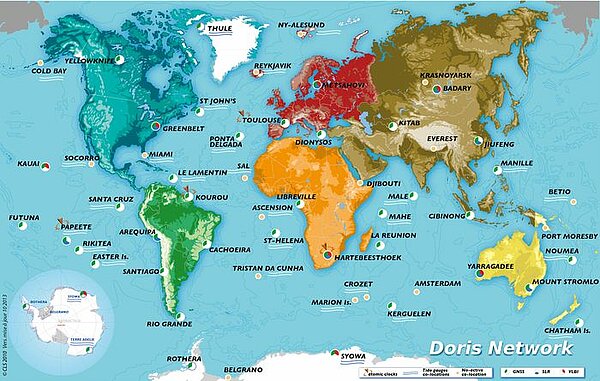Ground beacons
Since 1986, Cnes and IGN have deployed an international network of autonomous stations used as reference points on the ground to cover the satellites trajectory continuously. The Doris system now includes about 60 stations spread around the globe, half of them is installed on islands or coastal areas, allowing a homogeneous coverage including the southern hemisphere. A ground station Doris is composed of a beacon (3 generations), an omnidirectional antenna and a set of optional meteorological sensors for pressure, temperature and humidity.
The ground station network is composed of several kind of beacons : permanent beacons, master beacons and occasional beacons. The permanent beacons represent the orbitography network enabling a precise determination of trajectory satellites. The three master beacons (Toulouse, Kourou, Harthebeesthoek) belong to the permanent network but have a a further role : they are responsible for ensuring synchronization of the system to the International Atomic Time. Finally, the occasional beacons are installed temporarily for geophysical and geodetic surveys (measuring the drift of a glacier ...).
Beacons transmit signals on two frequencies: 2036.25 MHz and 401.25 MHz. The latter frequency is modulated to send messages containing an ID number, timing information, data from the meteorological sensors, and engineering data (power, etc.).
There are two types of ground antennas. See the geometrical caracteristics
Further information :
- Doris network status report, J.Saunier, IDS Workshop, 2010. (pdf)
- Doris network 2006 review: renovation result, stability and co-location assessment, prospects. H. Fagard, IDS Workshop, 2006. (pdf)
- Geometrical caracteristics of the two types of ground antennas.





